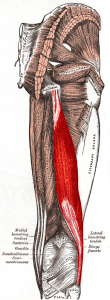Biceps pain in the thigh muscle
The hamstrings are located at the back of the leg. Through its passage through the knee and hip joints, it is responsible for many important movements, including knee flexion, hip addition and rotation, and pelvic flexion and elevation.
Pain in the biceps of the thigh muscle can mean several different injuries – from minor bruises, sprains and tears to the most severe tear. However, they all have similar reasons.
Symptoms and Causes of Femoral Biceps Injury
A bruised or tense hamstring muscle will produce milder symptoms than a torn or broken one, but none of these injuries should be ignored. What should we be alert to?
- pain in the biceps of the thigh muscle, i.e. in the back of the thigh – often sudden, burning,
- hematoma or bruise
- edema,
- decrease the range of motion of the legs,
- Soreness of the injury site and sensitivity to touch.
The causes of both injury and rupture of the biceps femoris are also similar. The most common are:
- no or insufficient warming up – not only warming up, but also muscle stretching,
- fast movement: jump, change direction, stop,
- overtraining and lack of recovery time or too much stress during training
- external force (e.g. hit, fall).
Ignoring the first signals from the body that warns us that muscles are overworked, we are subject to more serious injuries. Therefore, if our thigh muscles are making us feel unwell, it is best to start treatment immediately, because home remedies are sufficient for minor injuries.
But first, let’s explain the differences between the different types of injury.
Contusion of the biceps femoris
Contusion is damage mainly to the subcutaneous tissue and blood vessels. In the event of a severe contusion, the deep muscle layer can also be compromised. This injury is most often caused by a fall or hit, especially on a tense muscle, so it often happens that you interact with athletes such as football, handball and martial arts.

Contusion of the biceps femoris makes movement difficult. Therefore, at the level of limitation of movements in the joint, the doctor assesses the degree of injury: minor, rather severe or severe injury.
Tension of the biceps femoris
Muscle tension means less than 5% of its fiber is torn, which causes inflammation. This is most often caused by sudden movement (for example, exercising without warming up) or overworking during work (for example, exercising too intensely), but it can also be the result of stretching too much or hitting a very tense muscle.
How to distinguish a stretched biceps femoris from a torn one? The main difference is the degree of mobility limitation. After stretching, although it is very painful, we can still do even complex movements that would be impossible with a torn biceps femoris. However, this is very difficult to recognize without professional knowledge, so leave it to the experts.
Rupture of the biceps femoris
Rupture is a rupture of more than 5% of muscle microfibers. Here we are also dealing with pain, inflammation and – more than when pulled – limiting the range of motion. This happens in similar situations, but with greater stress on the muscles, that is, during intense training without warming up.
If you are interested in gaining muscle mass quickly, you can buy steroids by cash on delivery on the Steroidshop website. A wide range of pharmacology at the best prices from official suppliers
A rupture of the hamstring muscle differs from previous injuries by the appearance of muscle contraction and depression in the damaged area (most often at the interface between muscle and tendon) with thickening around the injury.
Ruptured biceps femoris
A rupture of the biceps femoris means damage to all or almost all of the fibers, and with them blood vessels and nerves. Therefore, the patient does not control the muscles, he feels very intense pain. Muscle tearing is also usually accompanied by a characteristic crunching or clicking sound.
The causes of injury are actually the same as when the thigh muscle is torn or stretched, only amplified. This acute injury can result from intense activity without warming up, especially among people who are not involved in regular sports, but it also happens to people using Anabole Mischung kaufen drugs that cause rapid muscle growth.
Biceps femoris – treatment of the most common injuries
When any of the above injuries occur, quick action is essential. Stop activities immediately and avoid movements that cause pain. It is also best to immediately use the anti-swelling position (leg elevation) to improve blood flow and apply cold compresses.
For diagnosis, your doctor may do ultrasound (to assess the extent of the injury) and x-rays (to rule out a fracture that may be associated with more serious muscle damage).
Complex cases of rupture of the biceps femoris may require surgery.
minor injuries, such as bruises or sprains of the biceps muscle of the thigh, are treated with rest, decreased activity, and pharmacotherapy (pain relievers and anti-inflammatory drugs).
Conservative trauma treatment can be supported by a variety of types of physiotherapy treatments, including:
- laser therapy (also with high energy), which heats the affected tissue and stimulates its regeneration,
- local cryotherapy that relieves pain and stimulates blood circulation,
- ultrasound therapy with biostimulating, analgesic and anti-inflammatory effects,
- magnetotherapy, which acts as an analgesic and accelerates healing,
- Kinesitherapy focused on muscle strengthening and stretching exercises
- massage to strengthen damaged muscles.
One of the most effective therapies for hip injuries is in a separate article: Hip Injuries – High Energy Laser Treatment, and below we present what the procedure looks like:
Of course, as with any injury, prevention is very important after a hip injury. The patient should follow the recommendations regarding both the treatment period and the follow-up, as injuries such as sprained or broken hamstrings tend to recur. This is why it is so important to warm up and avoid overtraining.
